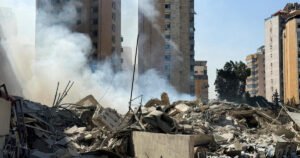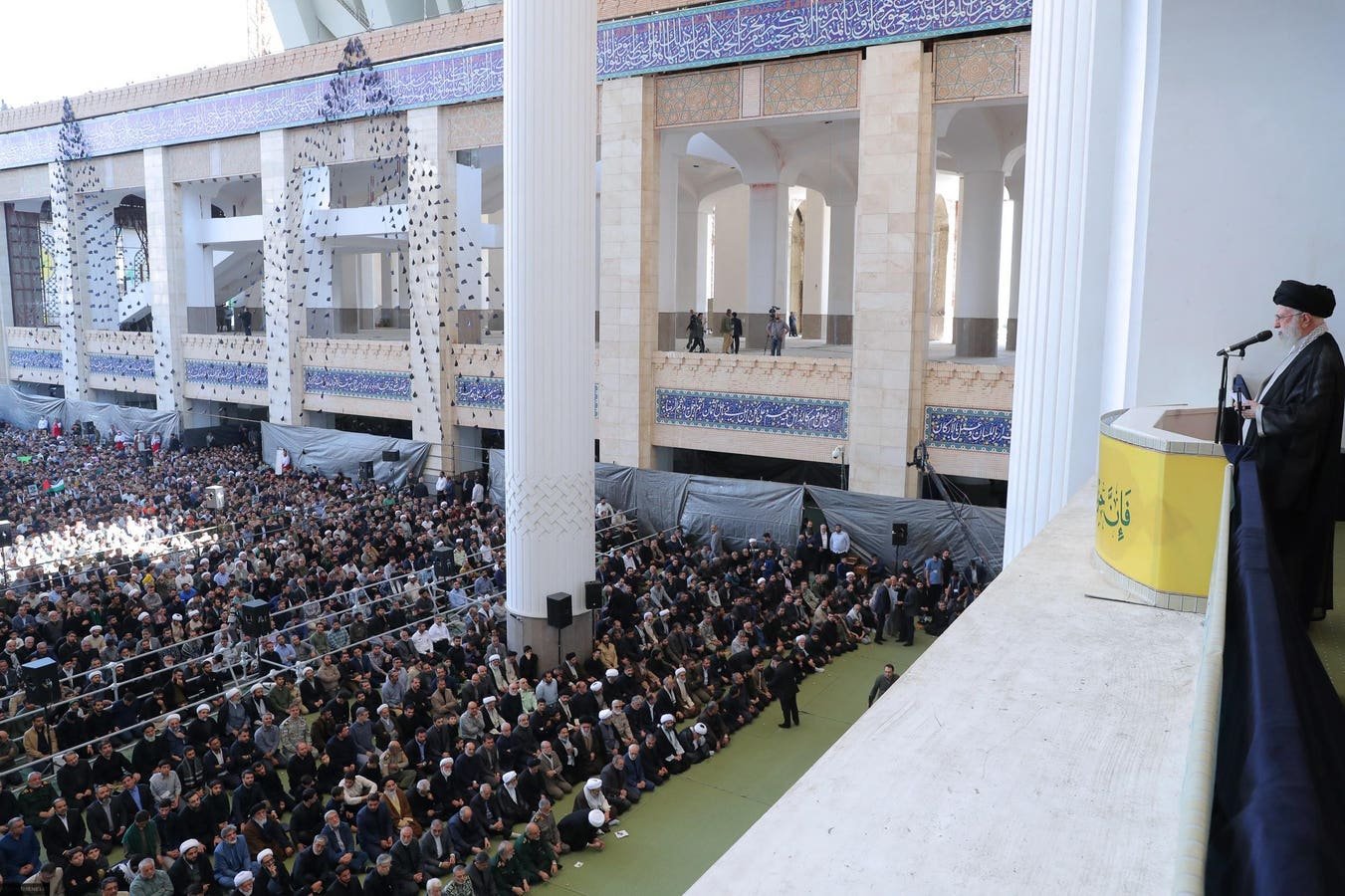
TEHRAN, IRAN – OCTOBER 4: In this handout image provided by the Iranian Leader’s Press Office, … [+]
Iranian Leader’s Press Office via Getty Images
Iran’s Supreme Leader, Ali Khamenei, appeared in public on Friday to announce Iran will continue supporting its regional proxies against Israel despite them coming under unprecedented attack and pressure.
“The resistance in the region will not back down even with the killing of its leaders,” Khamenei declared at Friday prayers in Tehran.
The supreme leader, who has the final say in all affairs in Iran since 1989, also dubiously claimed that Israel “cannot seriously harm” neither Hezbollah nor Hamas and said the latter’s fight against Israel provides a “vital service for the entire region.”
His appearance came less than a week after Iran launched its largest-ever ballistic missile strike against Israel on Tuesday. It also follows a deadly Israeli air and ground campaign in Lebanon, suspected Israeli sabotage of Hezbollah communications with explosive-packed pagers, the assassination of longtime Hezbollah leader Hassan Nasrallah, and airstrikes and a rare commando raid in Syria.
These actions badly hurt Iran’s most militarily powerful regional proxy, prompting Tehran to lash out with Tuesday’s strike, launching a massive barrage of at least 180 ballistic missiles, including some of its most advanced models. That attack ultimately caused minor damage to Israeli homes and a large airbase but no casualties inside Israel—although falling shrapnel did kill a 38-year-old Palestinian in the West Bank. While none of its military capabilities, the targeted airbase houses many of Israel’s most advanced fifth-generation F-35 aircraft, were destroyed in the attack, Israel had to expend several multi-million-dollar Arrow interceptor missiles to counter the incoming missiles.
Following the attack, a senior Israeli military official said, “We should expect to strike government centers and possibly eliminate figures like Khamenei in Iran.” Pro-government media in Iran lauded the supreme leader for appearing in public in light of such threats and Israel’s more general track record of successfully assassinating senior figures inside Iran.
Khamenei reportedly warned Nasrallah in the days leading up to his September 27 assassination to leave Lebanon. Following the simultaneous detonation of thousands of Hezbollah pagers and walkie-talkies on September 17-18—injuring thousands of members and disrupting the group’s communications—Khamenei sent a brigadier general in Iran’s Islamic Revolutionary Guard Corps, Abbas Nilforoushan, to Beirut to convince Nasrallah. Nilforoushan subsequently perished in the same devastating Israeli strike that killed Nasrallah.
As Hezbollah’s secretary-general since February 1992, Nasrallah was undoubtedly and the single most important figure in Iran’s regional militia proxies, the self-styled Axis of Resistance. For Khamenei, his loss was as consequential, if not more so, than the US assassination of the IRGC extraterritorial Quds Force commander, Qassem Soleimani, in a January 2020 US drone strike in Baghdad.
Israel is also believed to have targeted Nasrallah’s presumed successor, Hashem Safieddine, in heavy airstrikes on a bunker in Beirut on Thursday night.
Israel has also been busy afflicting potentially mortal blows against Hezbollah’s powerful rocket and missile arsenal, estimated to number anywhere from 150,000 to 200,000 surface-to-surface projectiles, including long-range and precision-guided munitions.
Israel launched its current offensive against Hezbollah—dubbed Operation Northern Arrows—on September 23, with the Israeli Air Force executing its most extensive airstrikes ever, using 250 fighter jets to strike 1,600 Hezbollah targets on that day. While undoubtedly devastating, the Israeli military said at the beginning of the campaign that reports of these airstrikes destroying 50 percent of Hezbollah’s rockets were most likely exaggerated.
However, by October 1, senior Israeli and American officials assessed that the Israeli air campaign has destroyed half of the militia’s missiles and rockets. However, they again noted that the surviving half of arsenal could still pose a significant threat to Israel.
For years, analysts assessed that a Third Lebanon War could see Hezbollah unleash an enormous missile and rocket barrage, overwhelming Israel’s multilayered air defense and causing significant casualties and extensive damage. For example, veteran journalist and Hezbollah expert Nicholas Blanford predicted that such a scenario could see Israel’s home front “experience its greatest destruction and loss of life since the 1948 war” while Lebanon would become a parking lot.
Since September 23, as it potentially faces a “use it or lose it” scenario with its arsenal, Hezbollah has mainly used short-range rockets, only launching a single ballistic missile toward Tel Aviv on September 25, which Israeli air defenses swiftly intercepted. Iran had helped Hezbollah to build up this arsenal primarily to deter an Israeli airstrike against its nuclear program. It’s widely speculated that one reason Hezbollah did not unleash more missiles since it was awaiting authorization from Tehran. On the other hand, Israeli attacks on and sabotage of its command, control, and communications could have also been the primary factor.
While Israel is unlikely to prove capable of destroying this entire arsenal with airstrikes alone, it could severely cripple it, stripping Hezbollah of its main strategic asset and Iran of its main regional deterrent against Israel. Furthermore, Hezbollah may find it difficult to replenish its losses in the short term if the current fighting stops soon.
As The New York Times reported, the current Israeli campaign—which also includes an ongoing ground incursion into South Lebanon that has already resulted in deadly clashes, with eight Israeli soldiers killed on Wednesday—did not begin in Lebanon but next door in Syria.
More than a week before the pager explosions, Israel launched airstrikes against Syria on September 8, itself not unusual. However, this time, an estimated 100 helicopter-borne commandos raided an underground Hezbollah missile production facility deep near northwestern Syria’s Masyaf, not far from the Lebanese border.
The facility previously belonged to the Syrian Scientific Studies and Research Center, which manufactured Syria’s notorious chemical weapons. It was built too deep underground for bunker-buster bombs, like the ones believed to have been used to kill Nasrallah in his Beirut bunker, to damage sufficiently. So, the commandos raided the facility, planting explosives to destroy the equipment used to manufacture Hezbollah missile components. They were in and out in only 15 minutes.
“It initially looked to be a one-off attack on a Hezbollah weapons facility, but it now appears to have been the opening salvo in a covert-in-name-only campaign against the Iranian proxy group,” the Times report noted.
How all of this ends is impossible to predict. Khamenei’s reiteration on Friday that his regime won’t back down comes as Israel has vowed to retaliate directly against Iran for Tuesday’s missile attack, which could see this already deadly Middle East conflagration spread even further.
For now, it seems clear that Iran’s regional proxies may well have endured their deadliest days ever and mightn’t fully recuperate their former strength and many of the military capabilities they possessed just over a mere week ago.
[ad_2]
Share this content:
